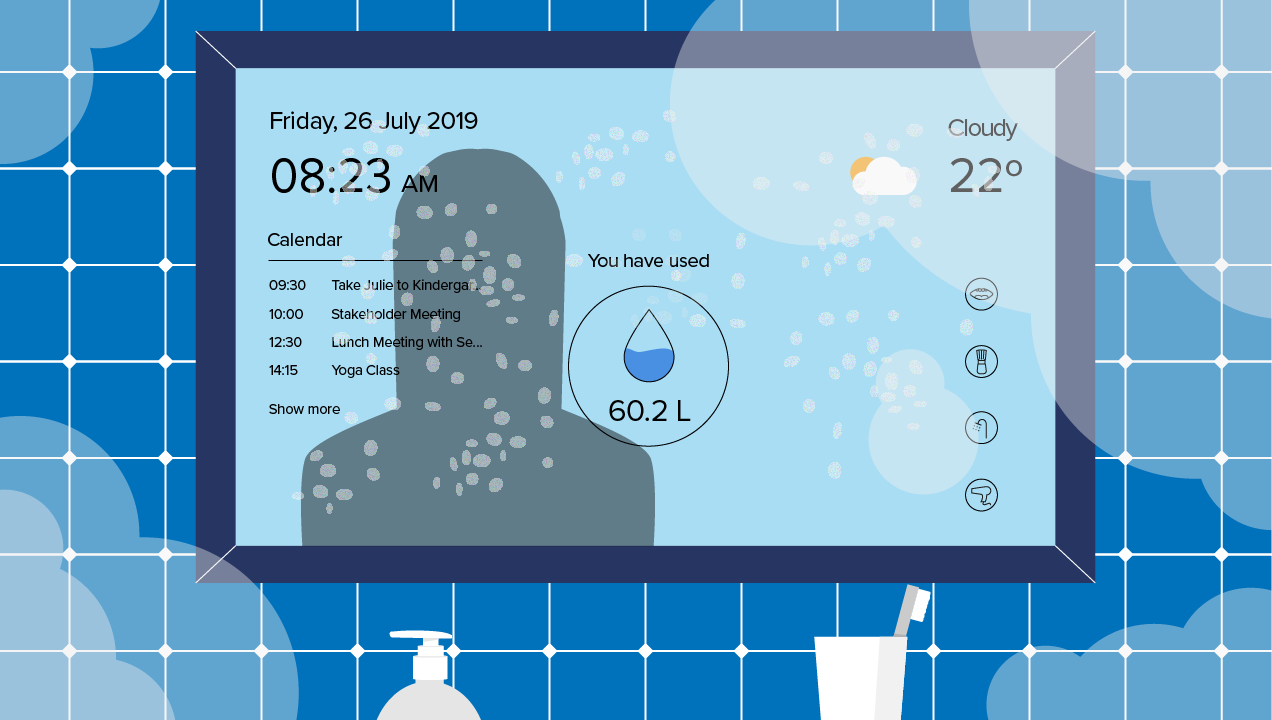Design Red Herrings: Where’s Your Ecosystem?
In Part One of our spotter’s guide to design red herrings, we considered how products like the headline grabbing voice-enabled toilet at CES this year, are more intended to showcase the engineering talent that made them than actually introduce a sustainable product design that meets a genuine human need. In this post, I’m going to explore the fundamental shift in product design that was enabled by digital services, a sea change in design philosophies that means even some products that appear to be genuine attempts at designing for consumers are, in reality, just another species of that pesky red fish.

All images: Sonja Kozik
Through the third lens
Last time we considered the three lenses through which successful innovations have to be visible; lens 1 is discovering the human need, lens 2 is equipping ourselves with tools to meet the need, and lens 3 is enabling new, valuable experiences through the tools we create. This framework for defining successful innovation was turbo-charged by the evolution of the internet and digital connectivity. For example, you can see how the telephone met a human need for long distance communication, and equipping ourselves with telecoms enabled a whole range of new experiences, like operator services, and emergency calls for fire, police and ambulance. However, the evolution of digital services enabled something more transformative for human experiences – and in doing so, transformed our understanding of design – because it blurred the distinction between products and services forever.
If that seems like a bold statement, let’s try this little thought experiment…
- Ask yourself if you’d spend the money on the smartphone in your pocket if it just made telephone calls and sent SMS messages. Would that level of functionality justify the price tag of the latest iPhone or Galaxy or Pixel? No.
- Okay, so let’s add the ability to play HD movies and high quality audio, would that justify the price? Maybe, but what if you had to load everything onto the phone first from a computer or CD player, not via a streaming service? No.
- If the statements above are true, then the smartphone product with all the capabilities designed into it, is not the totality of the product you’re buying. You’re buying a smartphone and access to an ecosystem of streaming media services, games, apps and social media platforms.
We arrive back at the bold statement I made earlier, is that smartphone great product design, service design, or both? Not such a bold statement after all, is it?
Red herrings are products without an ecosystem
So these days, you might argue a product needs an ecosystem to really make sense. In fact, if you take fairly average products like Beats headphones, you see the ecosystem can work feats of magic for products. Beats sold to Apple for billions dollars, yes, Apple, who make groundbreaking, highly desirable products all day long. Did they need Beats wifi headphones, or the Beats-Music streaming service and artist ecosystem that came with them, and became Apple Music? You do the ecosystem math.
This leads us back to CES, where we can try another quick thought experiment to test that idea:
Take two CES product categories, Smart Mirrors and 8K OLED televisions. These represent two very different design philosophies. One genre of product meets a human need and enables valuable new experiences. The other genre, is a red herring. But which is which?
At first, it’s a tough call. The smart mirrors at CES all feature voice assistants, and the ability to use facial recognition or biometric scanning to perform some sort of wizardry like picking out clothes to fit you in a dressing room, or tracking your wrinkles and helping you improve your skin. The slew of 8K OLED TVs come in all shapes and sizes, curves, transparent, built into windows, offering the very highest resolutions and sound quality we’ve ever experienced. So which one is the red herring?
Well, to answer that question, we need to go back to the root of all good product and service design, anthropology and design research. Let’s consider these technologies in a home, being used by real people in real contexts.
- Different rooms in the house are characterized by different needs, and in that context, you can see how a mirror that scans your wrinkles might feel like a red herring, but a hallway mirror that displays the weather forecast and temperature suddenly makes sense because that’s where you put on your coat and shoes, and decide to take an umbrella or not.
- Many homes have bathroom mirrors with lights, or magnifying mirrors for applying make-up or shaving. These are well established products, so digitising those products makes sense.
- In a world where people wear Fitbits to track their health, and apps that track nutrition and weight, a mirror that connects to those kinds of lifestyle health monitor by measuring other vectors of your shape and size could be useful.
- What we are witnessing here, interestingly, is not so much the design of a mirror as a way to integrate a service ecosystem into your home when you are hands-free and multitasking, rather than expecting you to touch your smartphone.
On the other hand, who needs a giant folding 8K TV that’s semi-transparent so you can see through it? Er, well, when you put it like that…
- The 8K OLED mega-TVs are undeniably clever, but in anthropological terms, the TV is generally placed on one edge of the living room, the sound quality really just needs to be loud enough to cut through the noise of the household.
- A see-through TV display is clever, but also strange. Think about it, a TV that is also a window? Not a great TV picture if you can kind of see through it, or a particularly good window because you kind of can’t. So why? So you can watch TV while you are looking out of the window, presumably. Maybe that makes sense in a luxury hotel lobby or an event stand, like at CES, but that’s a niche, not a user need.
- Regardless of how many thousand pixels it can display is limited by the ecosystem of TV content most of which is just normal HD and so it makes no difference to a great deal of content. The household might be watching cartoons, old movies, live sports, broadcast sitcoms, talent shows, or whatever, in a variety of different lighting contexts and room sizes.
- The design research would tell you the 8K OLED TV is a technological showcase, but in product design terms, it’s a red herring.
Did they need Beats wifi headphones, or the Beats-Music streaming service and artist ecosystem that came with them, and became Apple Music? You do the ecosystem math.
Don’t imagine the future, react to the present
Red herring products without an ecosystem are usually attempts to imagine the future. They are interesting design exercises and concepts, but that’s not what product design is all about. Steve Jobs famously said “Design is not just what it looks like and feels like. Design is how it works.” and the ecosystem of apps and services are fundamental to how it works part of the equation.
It’s important to avoid what I call the blank sheet design trap. Ask a room full of people to imagine the future of a product, and draw it on a blank sheet of paper, and it’s an almost impossible task. For a designer, or an engineer, that same blank sheet might indulge their creativity, but it’s only useful to the point where you take the concept, make it into a prototype, give it to a room full of people, and see what happens.
That room full of people might find imagining the future on a blank sheet of paper is hard, but they can react and critique a prototype very effectively. Similarly, give an engineer and a designer a prototype that’s been tested by that room of people, and they will design a much better product than their first blank sheet of paper concept. Give the designers and engineers a solid body of design research, anthropology, and a human-centric design framework to begin with, and that blank sheet of paper is transformed in its usefulness. Effective design and innovation is driven by human needs and user behaviors. Looking through the third lens we can see that our digitally-transformed needs and behaviors are increasingly blending products and services in complex digital ecosystems.
Red herrings are solutions looking for problems.
Even the latest wave of smartphones are turning red and swimming a bit. They are so thin and smooth you need to put a protective case on them, which renders them neither thin or smooth. The amazing camera quality is great, but not a patch on an actual camera, if you are into that sort of thing. The audio and video output is amazing, provided you have headphones or a bluetooth speaker, and good eyesight. What I really want is a battery that lasts for a week… oh. Selling me a new smartphone is impossible at the moment. That’s because my user behavior creates an unmet human need to be able to use the damn thing on Tuesday morning, even if I forget to charge it on Monday night. The screen resolution and camera megapixels are completely useless when you get off a 12-hour flight and realize it’s out of charge and your e-ticket is on it, too. New phone? No. Portable battery pack, yes.
The ecosystem, the harmony of product and service, that’s the design sweet spot. It has enabled remarkable new human experiences that meet a clear human need. Perhaps one of the best examples is the way we think about taxis now. Travelling by cab was always challenging for tourists because every country in the world has different taxi customs, and different standards. Travel guides always devote pages to this issue, how to get in the right licensed cabs, how to avoid rip-offs or worse, muggings and taxi crime. The smartphone-Uber-Lyft ecosystem changed all that. Now, increasingly, the taxi experience is the same predictable, cashless experience in many different places. That level of functionality doesn’t need an 8 Megapixel camera or dolby surround sound wireless earbuds, does it? No. It needs a product designed around an ecosystem of services.
Products, like people, need a sustainable ecosystem. They also need services that enable useful life experiences. Red herring designers say build it and they will come but successful designers and engineers know successful products are defined by the old adage use it or lose it.
If you missed it, in Part One of Design Red Herrings, we consider the Fashion Show Effect, and explore how attention grabbing headline products at shows like CES are often never really intended to be consumer products at all…
